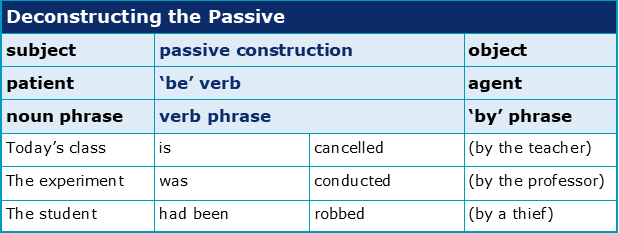Which 7 English passive constructions are useful?

This is the third of four chapters about Passive Constructions. To complete this reader, read each chapter carefully and then unlock and complete our materials to check your understanding.
– Review the basic construction using ‘be’ + past participle
– Introduce seven common structural considerations when using the passive voice
– Provide diagrams and examples to help guide the reader
Before you begin reading...
-
video and audio texts
-
knowledge checks and quizzes
-
skills practices, tasks and assignments
Chapter 3
Having now discussed the passive voice and how it differs in English from the active voice, and having explored the various uses for the passive in both general and academic English, Chapter 3 on this subject next focuses on the various passive constructions that students may wish to use in both their speech and writing. We’ve identified seven structural considerations below that learners of English may wish to recognise if they hope to use the passive confidently and correctly. These considerations vary from describing the basic form of the passive to exploring its interactions with tense, aspect, infinitives and other passivising verbs.
Structure 1: The Basic Construction
Firstly, it’s important that we remind ourselves of the basic passive construction as explored in Chapter 1. Remember that the passive is a structure in the English language in which the receiver of the action of a transitive verb (the patient) is moved to subject position, while the doer of the action of that verb (the agent) is optionally included in a prepositional ‘by’ phrase. This ordering of elements is precisely opposite to the more common active construction.
As can be seen in the following diagram, the two most important elements in forming the passive are the verb ‘be’ and the past participle of the main verb:

Structure 2: Modifying Tense and Aspect
As you may have noticed in the previous diagram, it’s also quite possible to modify the passive ‘be’ verb to indicate either tense or aspect, as in ‘was’ or ‘had been’. Indeed, both the present and past tenses, as well as the simple, continuous and perfect aspects, may be employed by the speaker or writer to alter the timeframe of the passive expressions. This has been exemplified for you in the following table:

Structure 3: Using Ditransitive Verbs
While the examples we’ve provided so far are monotransitive verbs and as such have only one direct object, the passive may also be used with ditransitive verbs that have both direct and indirect objects. Using the example ‘the speaker gave the students a lecture’, in which ‘give’ is the ditransitive verb, ‘the students’ the indirect object, and ‘a lecture’ the direct object, we can see in the diagram below how either object may be moved to the subject position depending upon the intended meaning:


Structure 4: Causative Constructions
The passive may also be used in causative constructions using the verbs ‘have’ and ‘get’, such as in ‘the students got/had the teacher fired’. In these special constructions, two standard rules of the passive are broken: (a) there is no use of the verb ‘be’, and (b) there is no movement of the agent or patient from the subject and object positions:



Structure 5: ‘Be’ vs. ‘Get’
Unlike ‘have’, ‘get’ may also be used in passive constructions which aren’t causative. Generally speaking, ‘get’ is more informal and colloquial than ‘be’ and should be used much less frequently. However, as the following examples show, ‘get’ may be the preferred verb if the action being passivised is unwelcome, unexpected or involuntary, or when something difficult was finally achieved:
“Our electricity got disconnected yesterday and we don’t know why.”
“After months of hard work, he finally got promoted to CEO.”
Structure 6: Infinitival Constructions
Some verbs known as complement-taking predicates are often followed by a ‘that’ clause instead of the more simple noun-phrase object. When passivised, however, complement-taking verbs such as ‘think’ or ‘understand’ must instead be followed by an infinitive clause using ‘to’ – such as ‘I’m thought to be interesting’. Likewise, and as the following table demonstrates, verbs such as ‘help’ or ‘make’ that are ordinarily followed by a bare infinitive (a verb in its base form without ‘to’) must be followed with an infinitive clause using ‘to’ when in the passive:


Structure 7: Using ‘It’
Finally, some reporting verbs such as ‘believe’, ‘claim’, ‘consider’ and ‘think’ are also able to be used in passive constructions with the empty pronoun ‘it’ as the subject of the clause. Expressions such as ‘It is claimed that…’ or ‘It is thought that…’ are in fact fairly common in academic writing. As such, these structures may be useful to learn and remember when using the passive in academic contexts.
Now that we’ve completed our third chapter on passive constructions, first complete the Chapter 3 activities and then continue on to the fourth and final lesson on this topic. In Chapter 4, we’ll discuss the five most common passive errors that students have a tendency to make.
Downloadbles
Once you’ve completed all four chapters in this short reader about Passive Constructions, you might then wish to download our Chapter Worksheets to check your progress or print for your students. These professional PDF worksheets can be easily accessed for only a few Academic Marks.
Chapter 1 explores the topic: How are active and passive constructions different? Our Chapter 1 Worksheet (containing guidance, activities and answer keys) can be accessed here at the click of a button.
Chapter 2 explores the topic: How can the passive be used in academic English? Our Chapter 2 Worksheet (containing guidance, activities and answer keys) can be accessed here at the click of a button.
Chapter 3 explores the topic: Which 7 English passive constructions are useful? Our Chapter 3 Worksheet (containing guidance, activities and answer keys) can be accessed here at the click of a button.
Chapter 4 explores the topic: Which 5 passive errors are common with students? Our Chapter 4 Worksheet (containing guidance, activities and answer keys) can be accessed here at the click of a button.
To save yourself 3 Marks, click on the button below to gain unlimited access to all of our Passive Constructions Chapter Worksheets. This All-in-1 Pack includes every chapter, activity and answer key related to this topic in one handy and professional PDF.
Collect Academic Marks
-
100 Marks for joining
-
25 Marks for daily e-learning
-
100-200 for feedback/testimonials
-
100-500 for referring your colleages/friends